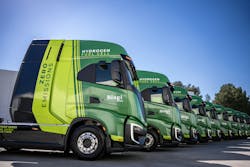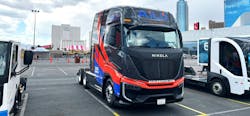Skepticism subsides as Nikola FCEV passes 1 million miles
In a June interview with Fleet Maintenance, zero-emission truck maker Nikola shared that its Nikola Tre FCEV has surpassed 1 million total miles driven. The tally started in 2022 with the “alpha” version of the fuel cell electric truck and has increased exponentially since the production models entered Nikola customer fleets late 2023.
FCEV customer use accounted for more than 300,000 miles, which range from owner-operator William Hall, who uses one for drayage operations, to Biagi Brothers, which has 10 in its California operations.
Nikola said the average fuel economy was 7.37 miles/kg. Users can’t disclose how much they pay for fuel, but a kilogram of H2 in California costs $32.94 as of June 3, according to analyst Platts.
The accumulated miles also include approximately 43,000 demo miles conducted by curious prospective customers and industry stakeholders. While a prototype predecessor of the Tre FCEV became infamous for rolling down a hill, these miles were all earned. According to Christian Appel, Nikola’s former chief engineer and current global head of program and product management, customer demoes ranged from one to eight weeks with the average length of haul at 187 miles.
That number might seem low, Appel acknowledged, but “the reason is typically those demo customers start out with shorter routes, because they have been suspicious about the range and the performance, and so they don't want to push it.”
He asserted fleets did not adapt operational parameters to cater to the Tre FCEV, with hauls at 55,000 lb. GVWR at the low end to the legal zero-emission vehicle max of 82,000 lb. GVWR.
Once they naturally gain more confidence in the new technology toward the end of the demo, “they typically push it you know to 350, 400, or even 450 miles,” Appel said.
Average demo efficiency is 8.13 miles/kg (9.07 miles/diesel gallon equivalent). Nikola reported demo uptime at just under 93%, and fueling uptime at 97.9%.
In the first half of 2024, Nikola has wholesaled 112 of the hydrogen-powered trucks, and beat its Q2 estimate of 60 by selling 72 FCEVs.
“We have maintained our 2024 momentum with solid wholesale numbers, new customers such as Walmart Canada, and repeat customers like 4GEN and IMC, purchasing vehicles through our dealer network,” said Nikola CEO Steve Girsky. “We are firmly on the field and are continuing to secure our first-mover advantage in zero-emissions Class 8 trucks in North America, as well as with our HYLA hydrogen refueling solutions.”
Another 1.5 million miles have been accrued by the Tre BEV, all of which were recalled last year for faulty batteries that could potentially catch fire. That issue was resolved, according to Nikola, with customers now receiving the remanned trucks, which get up to 330 miles per charge.
Fueling
Nikola has three modular HYLA stations in operation—at Ontario, Long Beach in southern California, and at the Nikola production facility in Coolidge, Arizona—with 70 metric tons of H2 dispensed over 2,000 fueling events since the start of 2024. Eleven more modular stations are planned by the end of the year.
Nikola sources both gaseous and liquid H2 through suppliers. Customers like Hall also fill up at the first heavy-duty hydrogen owned by FirstElement Fuel station in Oakland.
“There are multiple projects coming up in the next couple of months here that we're working together on with those partners that will establish additional sources," Appel said.
Looking to the future
Hydrogen still has a ways to go before proving itself viable, and Nikola is still working on cleaning up its own image tarnished by founder Trevor Milton, who was sentenced to four years in prison for misleading investors in December 2023.
The tide has turned since then, Appel said. In the last six months of conversations with industry leaders, he’s answered fewer questions expressing doubt in the technology and more about solving the “executional challenges” around hydrogen, such as which locations can support FCEVs and what the performance will be.
“Frankly they’re not necessarily easy to solve in all cases—don't get me wrong,” Appel said. “But that's more the discussions at this point that I'm experiencing with the fleets.”
When asked when a sleeper version of the FCEV will be available, something promised since the early days of Nikola, Appel indicated the focus now is on improving the Tre FCEV’s reliability and cost. According to reports, Nikola sells the Tre FCEV—before incentives—at $350,000, though the units cost $679,000 each to produce.
“We need to deliver a quality product—we just launched the product,” Appel said. “So there's tons of small continuous improvement measures that we're working through [on the design and manufacturing sides] to be more cost efficient.”
This includes over scaling production as well how the trucks are maintained and serviced.
Other focuses include making the trucks more efficient for users in terms of improving the drivetrain, fuel cells, and overall aerodynamics.
Finally, Apple noted the weight needs to come down to open up new markets.
“We cannot only stick with California,” Appel said. “Even though that remains an anchor point, we're exploring other pockets of the country.”
Nikola recently demoed the FCEV with Ethero in Maryland, and as Girsky noted, Walmart Canada has deployed a Tre FCEV in Mississauga, Ontario.
“This is a first for a retailer in Canada and is an example of how we will continue to push forward, embrace new technology and spark change within the industry,” said Gonzalo Gebara, president and CEO, Walmart Canada.
All these disparate examples are a good start, but hydrogen—and Nikola’s long term viability—won’t truly take root until a reliable nationwide corridor for fueling and service is establish
“Ultimately, yes, the last step is to connect all of these pockets, and to establish a kind of east-and-west route,” Appel agreed. “That will take some time.”
About the Author

John Hitch
Editor-in-chief, Fleet Maintenance
John Hitch is the award-winning editor-in-chief of Fleet Maintenance, where his mission is to provide maintenance leaders and technicians with the the latest information on tools, strategies, and best practices to keep their fleets' commercial vehicles moving.
He is based out of Cleveland, Ohio, and has worked in the B2B journalism space for more than a decade. Hitch was previously senior editor for FleetOwner and before that was technology editor for IndustryWeek and and managing editor of New Equipment Digest.
Hitch graduated from Kent State University and was editor of the student magazine The Burr in 2009.
The former sonar technician served honorably aboard the fast-attack submarine USS Oklahoma City (SSN-723), where he participated in counter-drug ops, an under-ice expedition, and other missions he's not allowed to talk about for several more decades.

